Nestle Company Analysis: Strategy, Marketing, and Innovation (MBA600)
VerifiedAdded on 2022/12/26
|11
|2956
|36
Report
AI Summary
This report provides a detailed analysis of the Nestle Company, examining its organizational strategy, business model, and various undertakings. The report delves into Nestle's operations, marketing, and product strategies, highlighting its growth and innovation initiatives. It emphasizes the use of research and insights, critically analyzes strategic implementation and changes, and discusses the company's operational processes. Recommendations are provided to identify opportunities for enhancing Nestle's future performance. The report covers Nestle's history, including its founding and subsidiaries, and its guiding principles, such as innovation, decentralization, and its "think globally, operate locally" approach. The analysis includes Nestle's marketing strategies, product development, innovation, and growth, including sales figures and operational changes. Furthermore, the report examines the company's strategic frameworks and implementation, offering recommendations for future improvements and growth.

Running Head: 600 2 NV
1
600 2 NV
Name
Professor
Course
Institution
Date
1
600 2 NV
Name
Professor
Course
Institution
Date
Paraphrase This Document
Need a fresh take? Get an instant paraphrase of this document with our AI Paraphraser
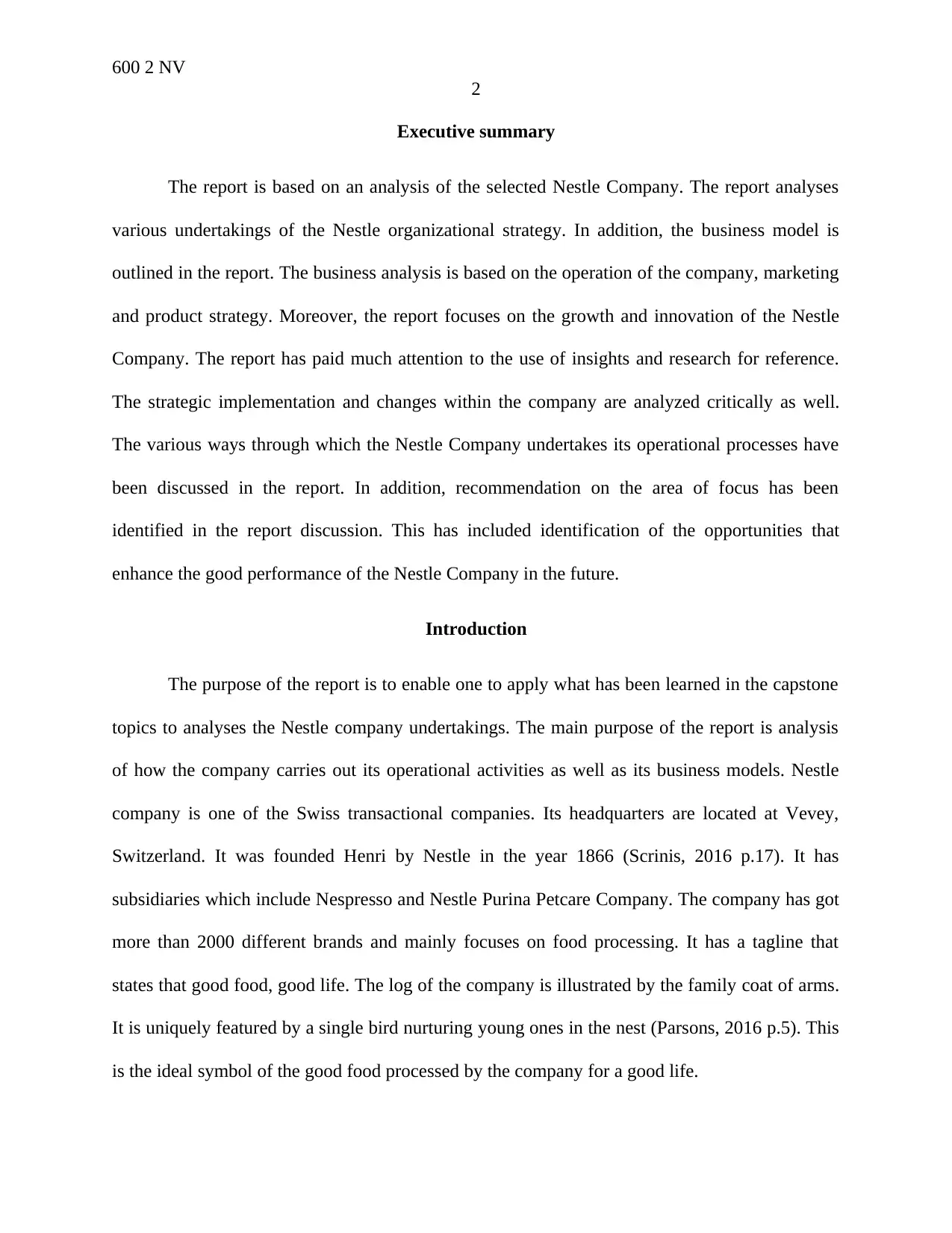
600 2 NV
2
Executive summary
The report is based on an analysis of the selected Nestle Company. The report analyses
various undertakings of the Nestle organizational strategy. In addition, the business model is
outlined in the report. The business analysis is based on the operation of the company, marketing
and product strategy. Moreover, the report focuses on the growth and innovation of the Nestle
Company. The report has paid much attention to the use of insights and research for reference.
The strategic implementation and changes within the company are analyzed critically as well.
The various ways through which the Nestle Company undertakes its operational processes have
been discussed in the report. In addition, recommendation on the area of focus has been
identified in the report discussion. This has included identification of the opportunities that
enhance the good performance of the Nestle Company in the future.
Introduction
The purpose of the report is to enable one to apply what has been learned in the capstone
topics to analyses the Nestle company undertakings. The main purpose of the report is analysis
of how the company carries out its operational activities as well as its business models. Nestle
company is one of the Swiss transactional companies. Its headquarters are located at Vevey,
Switzerland. It was founded Henri by Nestle in the year 1866 (Scrinis, 2016 p.17). It has
subsidiaries which include Nespresso and Nestle Purina Petcare Company. The company has got
more than 2000 different brands and mainly focuses on food processing. It has a tagline that
states that good food, good life. The log of the company is illustrated by the family coat of arms.
It is uniquely featured by a single bird nurturing young ones in the nest (Parsons, 2016 p.5). This
is the ideal symbol of the good food processed by the company for a good life.
2
Executive summary
The report is based on an analysis of the selected Nestle Company. The report analyses
various undertakings of the Nestle organizational strategy. In addition, the business model is
outlined in the report. The business analysis is based on the operation of the company, marketing
and product strategy. Moreover, the report focuses on the growth and innovation of the Nestle
Company. The report has paid much attention to the use of insights and research for reference.
The strategic implementation and changes within the company are analyzed critically as well.
The various ways through which the Nestle Company undertakes its operational processes have
been discussed in the report. In addition, recommendation on the area of focus has been
identified in the report discussion. This has included identification of the opportunities that
enhance the good performance of the Nestle Company in the future.
Introduction
The purpose of the report is to enable one to apply what has been learned in the capstone
topics to analyses the Nestle company undertakings. The main purpose of the report is analysis
of how the company carries out its operational activities as well as its business models. Nestle
company is one of the Swiss transactional companies. Its headquarters are located at Vevey,
Switzerland. It was founded Henri by Nestle in the year 1866 (Scrinis, 2016 p.17). It has
subsidiaries which include Nespresso and Nestle Purina Petcare Company. The company has got
more than 2000 different brands and mainly focuses on food processing. It has a tagline that
states that good food, good life. The log of the company is illustrated by the family coat of arms.
It is uniquely featured by a single bird nurturing young ones in the nest (Parsons, 2016 p.5). This
is the ideal symbol of the good food processed by the company for a good life.
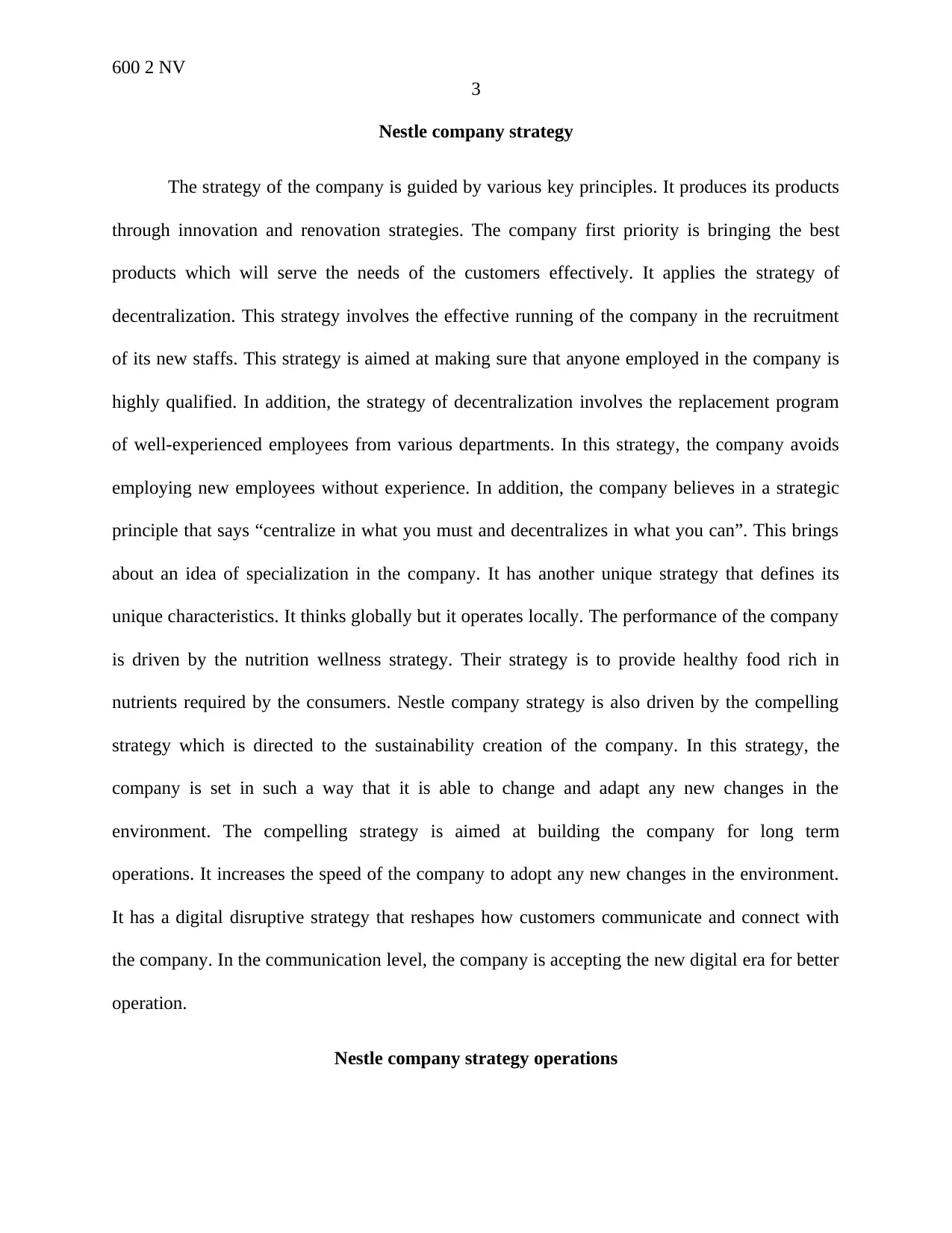
600 2 NV
3
Nestle company strategy
The strategy of the company is guided by various key principles. It produces its products
through innovation and renovation strategies. The company first priority is bringing the best
products which will serve the needs of the customers effectively. It applies the strategy of
decentralization. This strategy involves the effective running of the company in the recruitment
of its new staffs. This strategy is aimed at making sure that anyone employed in the company is
highly qualified. In addition, the strategy of decentralization involves the replacement program
of well-experienced employees from various departments. In this strategy, the company avoids
employing new employees without experience. In addition, the company believes in a strategic
principle that says “centralize in what you must and decentralizes in what you can”. This brings
about an idea of specialization in the company. It has another unique strategy that defines its
unique characteristics. It thinks globally but it operates locally. The performance of the company
is driven by the nutrition wellness strategy. Their strategy is to provide healthy food rich in
nutrients required by the consumers. Nestle company strategy is also driven by the compelling
strategy which is directed to the sustainability creation of the company. In this strategy, the
company is set in such a way that it is able to change and adapt any new changes in the
environment. The compelling strategy is aimed at building the company for long term
operations. It increases the speed of the company to adopt any new changes in the environment.
It has a digital disruptive strategy that reshapes how customers communicate and connect with
the company. In the communication level, the company is accepting the new digital era for better
operation.
Nestle company strategy operations
3
Nestle company strategy
The strategy of the company is guided by various key principles. It produces its products
through innovation and renovation strategies. The company first priority is bringing the best
products which will serve the needs of the customers effectively. It applies the strategy of
decentralization. This strategy involves the effective running of the company in the recruitment
of its new staffs. This strategy is aimed at making sure that anyone employed in the company is
highly qualified. In addition, the strategy of decentralization involves the replacement program
of well-experienced employees from various departments. In this strategy, the company avoids
employing new employees without experience. In addition, the company believes in a strategic
principle that says “centralize in what you must and decentralizes in what you can”. This brings
about an idea of specialization in the company. It has another unique strategy that defines its
unique characteristics. It thinks globally but it operates locally. The performance of the company
is driven by the nutrition wellness strategy. Their strategy is to provide healthy food rich in
nutrients required by the consumers. Nestle company strategy is also driven by the compelling
strategy which is directed to the sustainability creation of the company. In this strategy, the
company is set in such a way that it is able to change and adapt any new changes in the
environment. The compelling strategy is aimed at building the company for long term
operations. It increases the speed of the company to adopt any new changes in the environment.
It has a digital disruptive strategy that reshapes how customers communicate and connect with
the company. In the communication level, the company is accepting the new digital era for better
operation.
Nestle company strategy operations
⊘ This is a preview!⊘
Do you want full access?
Subscribe today to unlock all pages.

Trusted by 1+ million students worldwide
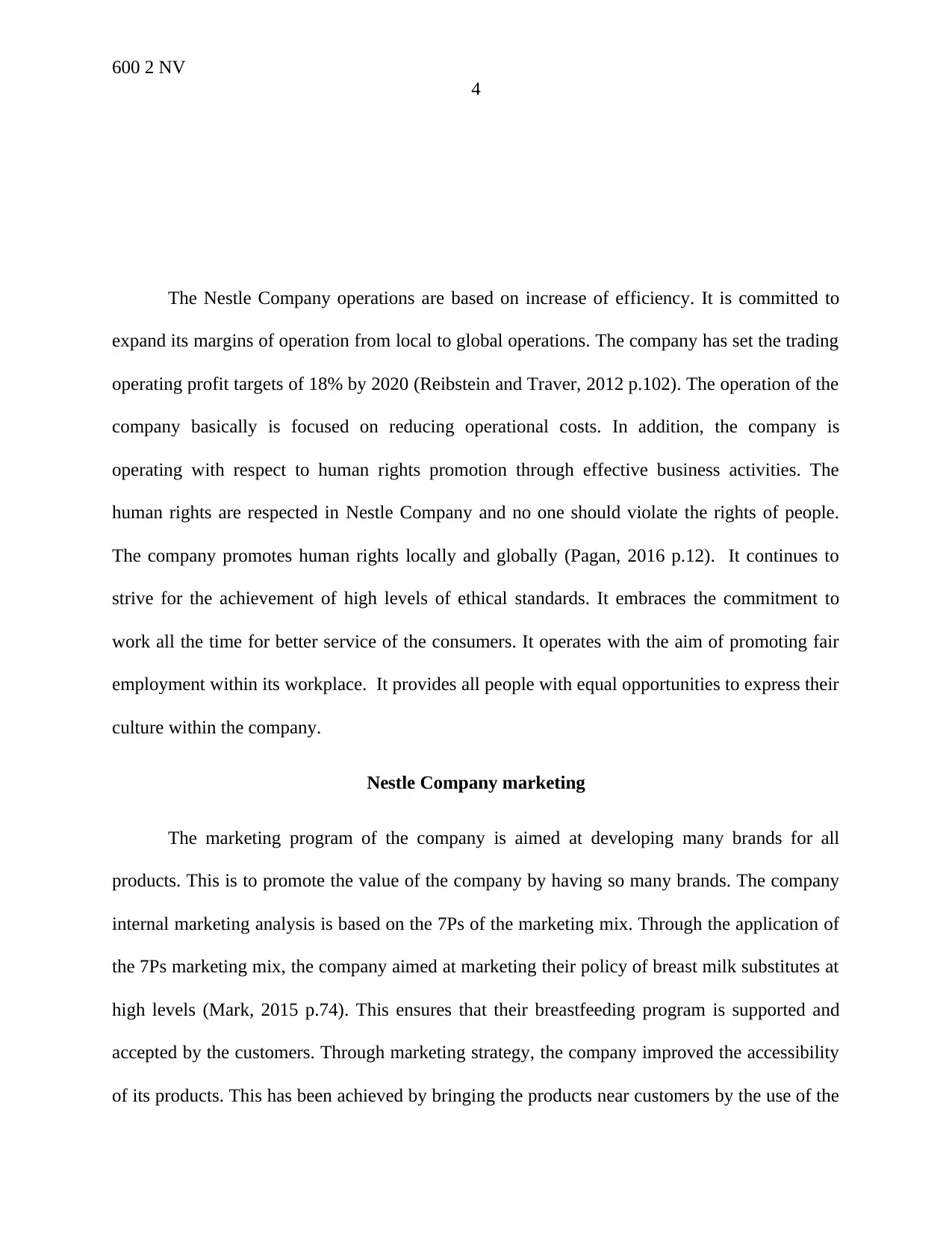
600 2 NV
4
The Nestle Company operations are based on increase of efficiency. It is committed to
expand its margins of operation from local to global operations. The company has set the trading
operating profit targets of 18% by 2020 (Reibstein and Traver, 2012 p.102). The operation of the
company basically is focused on reducing operational costs. In addition, the company is
operating with respect to human rights promotion through effective business activities. The
human rights are respected in Nestle Company and no one should violate the rights of people.
The company promotes human rights locally and globally (Pagan, 2016 p.12). It continues to
strive for the achievement of high levels of ethical standards. It embraces the commitment to
work all the time for better service of the consumers. It operates with the aim of promoting fair
employment within its workplace. It provides all people with equal opportunities to express their
culture within the company.
Nestle Company marketing
The marketing program of the company is aimed at developing many brands for all
products. This is to promote the value of the company by having so many brands. The company
internal marketing analysis is based on the 7Ps of the marketing mix. Through the application of
the 7Ps marketing mix, the company aimed at marketing their policy of breast milk substitutes at
high levels (Mark, 2015 p.74). This ensures that their breastfeeding program is supported and
accepted by the customers. Through marketing strategy, the company improved the accessibility
of its products. This has been achieved by bringing the products near customers by the use of the
4
The Nestle Company operations are based on increase of efficiency. It is committed to
expand its margins of operation from local to global operations. The company has set the trading
operating profit targets of 18% by 2020 (Reibstein and Traver, 2012 p.102). The operation of the
company basically is focused on reducing operational costs. In addition, the company is
operating with respect to human rights promotion through effective business activities. The
human rights are respected in Nestle Company and no one should violate the rights of people.
The company promotes human rights locally and globally (Pagan, 2016 p.12). It continues to
strive for the achievement of high levels of ethical standards. It embraces the commitment to
work all the time for better service of the consumers. It operates with the aim of promoting fair
employment within its workplace. It provides all people with equal opportunities to express their
culture within the company.
Nestle Company marketing
The marketing program of the company is aimed at developing many brands for all
products. This is to promote the value of the company by having so many brands. The company
internal marketing analysis is based on the 7Ps of the marketing mix. Through the application of
the 7Ps marketing mix, the company aimed at marketing their policy of breast milk substitutes at
high levels (Mark, 2015 p.74). This ensures that their breastfeeding program is supported and
accepted by the customers. Through marketing strategy, the company improved the accessibility
of its products. This has been achieved by bringing the products near customers by the use of the
Paraphrase This Document
Need a fresh take? Get an instant paraphrase of this document with our AI Paraphraser
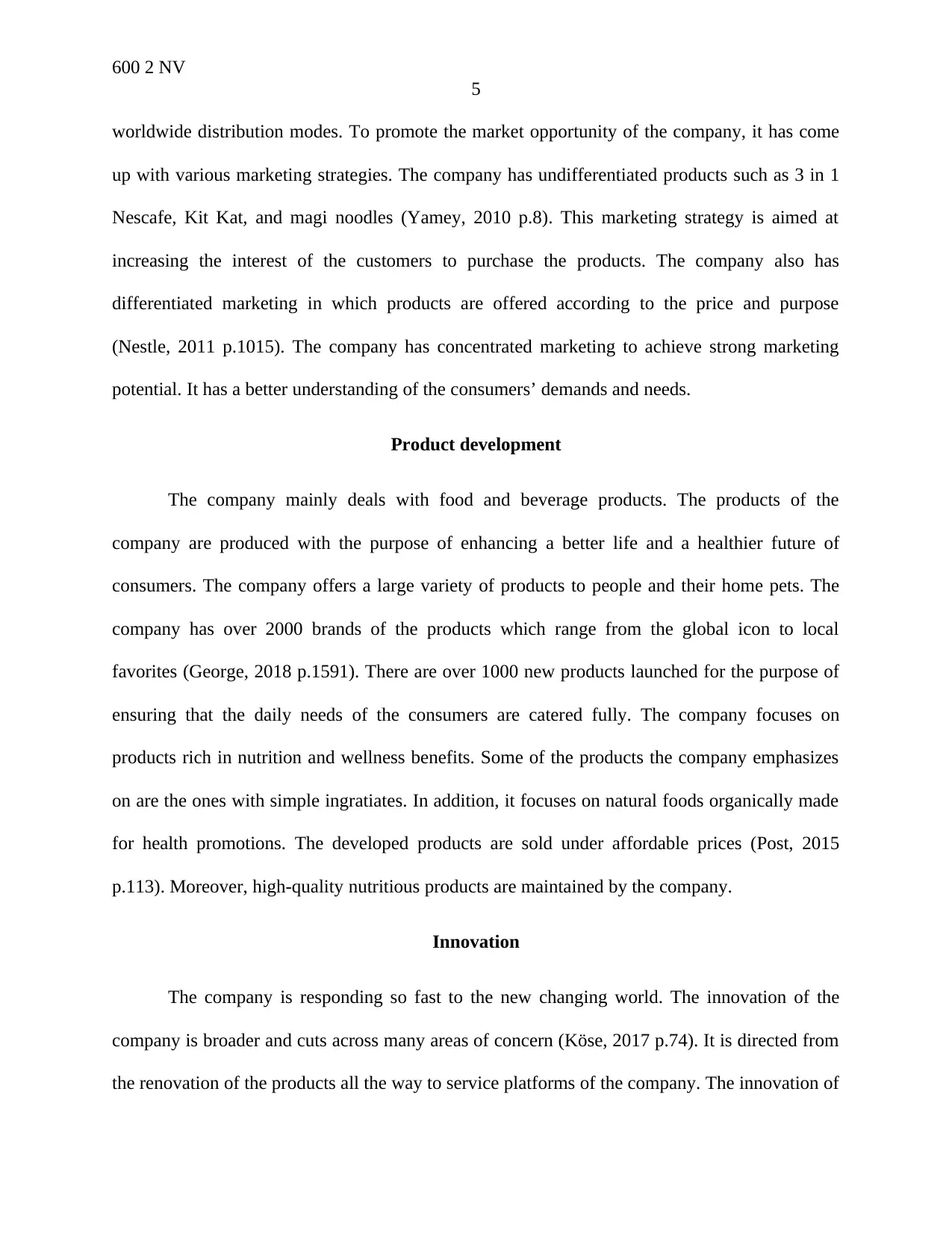
600 2 NV
5
worldwide distribution modes. To promote the market opportunity of the company, it has come
up with various marketing strategies. The company has undifferentiated products such as 3 in 1
Nescafe, Kit Kat, and magi noodles (Yamey, 2010 p.8). This marketing strategy is aimed at
increasing the interest of the customers to purchase the products. The company also has
differentiated marketing in which products are offered according to the price and purpose
(Nestle, 2011 p.1015). The company has concentrated marketing to achieve strong marketing
potential. It has a better understanding of the consumers’ demands and needs.
Product development
The company mainly deals with food and beverage products. The products of the
company are produced with the purpose of enhancing a better life and a healthier future of
consumers. The company offers a large variety of products to people and their home pets. The
company has over 2000 brands of the products which range from the global icon to local
favorites (George, 2018 p.1591). There are over 1000 new products launched for the purpose of
ensuring that the daily needs of the consumers are catered fully. The company focuses on
products rich in nutrition and wellness benefits. Some of the products the company emphasizes
on are the ones with simple ingratiates. In addition, it focuses on natural foods organically made
for health promotions. The developed products are sold under affordable prices (Post, 2015
p.113). Moreover, high-quality nutritious products are maintained by the company.
Innovation
The company is responding so fast to the new changing world. The innovation of the
company is broader and cuts across many areas of concern (Köse, 2017 p.74). It is directed from
the renovation of the products all the way to service platforms of the company. The innovation of
5
worldwide distribution modes. To promote the market opportunity of the company, it has come
up with various marketing strategies. The company has undifferentiated products such as 3 in 1
Nescafe, Kit Kat, and magi noodles (Yamey, 2010 p.8). This marketing strategy is aimed at
increasing the interest of the customers to purchase the products. The company also has
differentiated marketing in which products are offered according to the price and purpose
(Nestle, 2011 p.1015). The company has concentrated marketing to achieve strong marketing
potential. It has a better understanding of the consumers’ demands and needs.
Product development
The company mainly deals with food and beverage products. The products of the
company are produced with the purpose of enhancing a better life and a healthier future of
consumers. The company offers a large variety of products to people and their home pets. The
company has over 2000 brands of the products which range from the global icon to local
favorites (George, 2018 p.1591). There are over 1000 new products launched for the purpose of
ensuring that the daily needs of the consumers are catered fully. The company focuses on
products rich in nutrition and wellness benefits. Some of the products the company emphasizes
on are the ones with simple ingratiates. In addition, it focuses on natural foods organically made
for health promotions. The developed products are sold under affordable prices (Post, 2015
p.113). Moreover, high-quality nutritious products are maintained by the company.
Innovation
The company is responding so fast to the new changing world. The innovation of the
company is broader and cuts across many areas of concern (Köse, 2017 p.74). It is directed from
the renovation of the products all the way to service platforms of the company. The innovation of

600 2 NV
6
the company begins with the modification of the company’s core portfolio to produce quality
products. In addition the company focuses on scaling new brands of products according to the
demands of the consumers. The company has invented advanced service delivery and selling
methods. It is applying online e-selling programs to make sure that the product reaches a wide
variety of potential customers (Blockeel et al, 2016 p.491). The company is well equipped with
e-commerce programs as well as digital marketing. In respect to this, it carries out its marketing
process through the use of social media platforms such as and Facebook and Instagram.
The company growth
The company has experienced a fast and wide margin of growth both locally and
globally. The growing sales of the company have grown up to about 89.7 billion group sales in
CHF. Organic food sales growth has increased by 2.4%. The internal growth rate of the company
is approximated to be grown with an increase of 1.6% (Stratiki, 2017 p.575). The profit
operational growth has increased up to 14.8 billion in CHF. The trading operations of the
company have increased by 14.6% profit margin. The earnings per share of the company have
grown up to 2.32 while underlying per-share earnings increased by +4.7%. The operational cash
flow of the company is 13.4 billion which is approximately 75.4% of net financial debt (Green,
2016 p.64). The proposed dividend of the company has shown an increase of +2.2%.
The company change
The company is simplifying its operations by strengthening its decision-making
strategies. The company has changed its infant nutritional business from the global level to the
local level. These changes are aimed at making sure that the company not only operates globally
but also locally. The company has created a unit known as a strategic business unit that is aimed
6
the company begins with the modification of the company’s core portfolio to produce quality
products. In addition the company focuses on scaling new brands of products according to the
demands of the consumers. The company has invented advanced service delivery and selling
methods. It is applying online e-selling programs to make sure that the product reaches a wide
variety of potential customers (Blockeel et al, 2016 p.491). The company is well equipped with
e-commerce programs as well as digital marketing. In respect to this, it carries out its marketing
process through the use of social media platforms such as and Facebook and Instagram.
The company growth
The company has experienced a fast and wide margin of growth both locally and
globally. The growing sales of the company have grown up to about 89.7 billion group sales in
CHF. Organic food sales growth has increased by 2.4%. The internal growth rate of the company
is approximated to be grown with an increase of 1.6% (Stratiki, 2017 p.575). The profit
operational growth has increased up to 14.8 billion in CHF. The trading operations of the
company have increased by 14.6% profit margin. The earnings per share of the company have
grown up to 2.32 while underlying per-share earnings increased by +4.7%. The operational cash
flow of the company is 13.4 billion which is approximately 75.4% of net financial debt (Green,
2016 p.64). The proposed dividend of the company has shown an increase of +2.2%.
The company change
The company is simplifying its operations by strengthening its decision-making
strategies. The company has changed its infant nutritional business from the global level to the
local level. These changes are aimed at making sure that the company not only operates globally
but also locally. The company has created a unit known as a strategic business unit that is aimed
⊘ This is a preview!⊘
Do you want full access?
Subscribe today to unlock all pages.

Trusted by 1+ million students worldwide
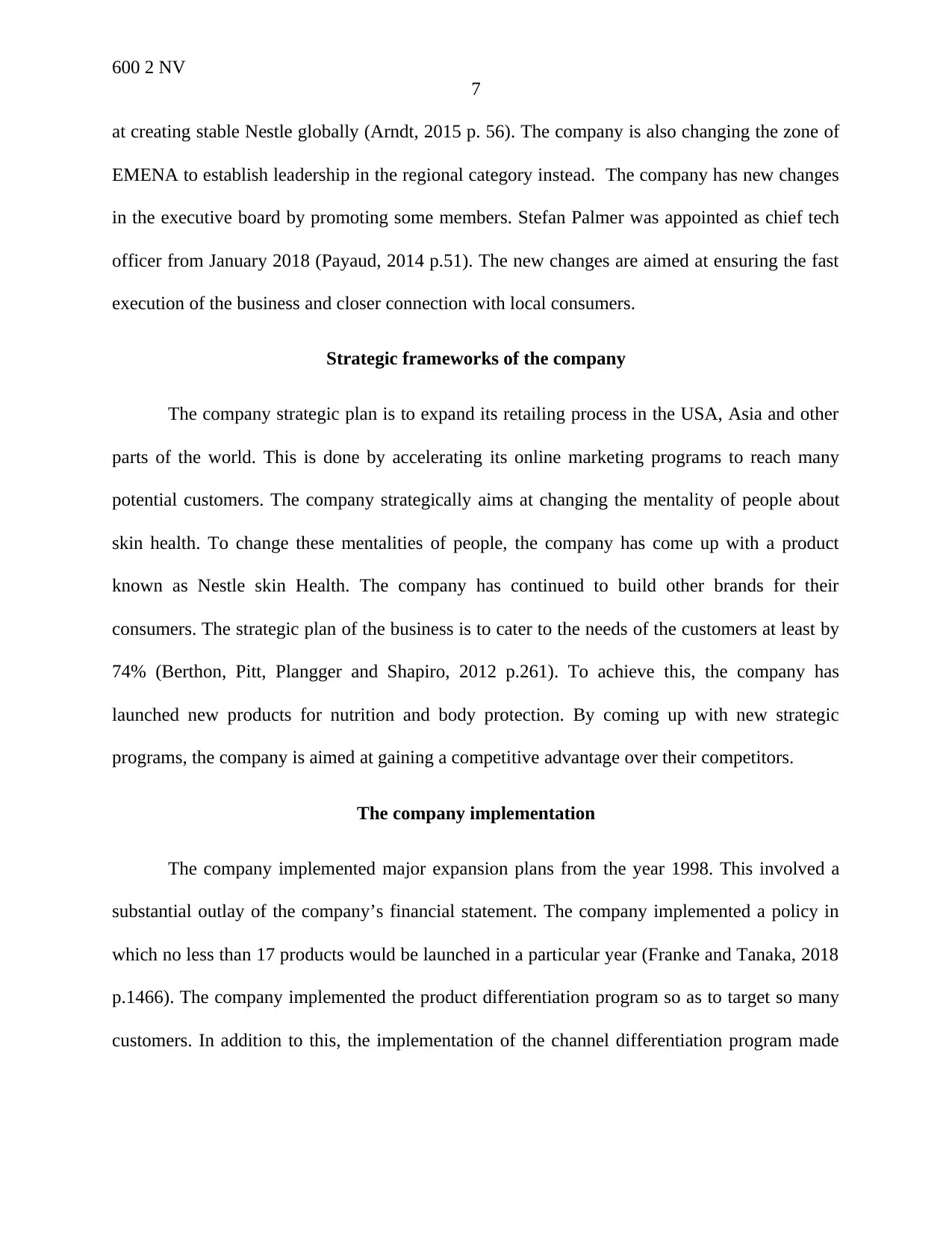
600 2 NV
7
at creating stable Nestle globally (Arndt, 2015 p. 56). The company is also changing the zone of
EMENA to establish leadership in the regional category instead. The company has new changes
in the executive board by promoting some members. Stefan Palmer was appointed as chief tech
officer from January 2018 (Payaud, 2014 p.51). The new changes are aimed at ensuring the fast
execution of the business and closer connection with local consumers.
Strategic frameworks of the company
The company strategic plan is to expand its retailing process in the USA, Asia and other
parts of the world. This is done by accelerating its online marketing programs to reach many
potential customers. The company strategically aims at changing the mentality of people about
skin health. To change these mentalities of people, the company has come up with a product
known as Nestle skin Health. The company has continued to build other brands for their
consumers. The strategic plan of the business is to cater to the needs of the customers at least by
74% (Berthon, Pitt, Plangger and Shapiro, 2012 p.261). To achieve this, the company has
launched new products for nutrition and body protection. By coming up with new strategic
programs, the company is aimed at gaining a competitive advantage over their competitors.
The company implementation
The company implemented major expansion plans from the year 1998. This involved a
substantial outlay of the company’s financial statement. The company implemented a policy in
which no less than 17 products would be launched in a particular year (Franke and Tanaka, 2018
p.1466). The company implemented the product differentiation program so as to target so many
customers. In addition to this, the implementation of the channel differentiation program made
7
at creating stable Nestle globally (Arndt, 2015 p. 56). The company is also changing the zone of
EMENA to establish leadership in the regional category instead. The company has new changes
in the executive board by promoting some members. Stefan Palmer was appointed as chief tech
officer from January 2018 (Payaud, 2014 p.51). The new changes are aimed at ensuring the fast
execution of the business and closer connection with local consumers.
Strategic frameworks of the company
The company strategic plan is to expand its retailing process in the USA, Asia and other
parts of the world. This is done by accelerating its online marketing programs to reach many
potential customers. The company strategically aims at changing the mentality of people about
skin health. To change these mentalities of people, the company has come up with a product
known as Nestle skin Health. The company has continued to build other brands for their
consumers. The strategic plan of the business is to cater to the needs of the customers at least by
74% (Berthon, Pitt, Plangger and Shapiro, 2012 p.261). To achieve this, the company has
launched new products for nutrition and body protection. By coming up with new strategic
programs, the company is aimed at gaining a competitive advantage over their competitors.
The company implementation
The company implemented major expansion plans from the year 1998. This involved a
substantial outlay of the company’s financial statement. The company implemented a policy in
which no less than 17 products would be launched in a particular year (Franke and Tanaka, 2018
p.1466). The company implemented the product differentiation program so as to target so many
customers. In addition to this, the implementation of the channel differentiation program made
Paraphrase This Document
Need a fresh take? Get an instant paraphrase of this document with our AI Paraphraser

600 2 NV
8
sure that the products reach their consumers through salesmen. This implementation is aimed at
making sure that the company products reach all their potential customers on time.
Recommendations
The company management team should be able to determine the validity of the company
plans. The company should focus on the implementation of new products in order to cater to the
needs of the customers fully. It should come up with new ways of enriching their infant food
products with vitamins and other nutritional substances. This will be an important initiative as it
will provide the daily needs of children. It should venture into a partnership with other
organizations in order to get a competitive advantage. However, the company should avoid
partnering with any organization which cannot sustain the market pressure of competitors. The
Nestle Company should choose a more qualified and potential company with better performance.
The company should focus on more innovations and renovations of their products for better
performance in the future.
Conclusion
Through the analysis of the company undertakings, it has been found that the company is
able to maintain its growth level. It has advanced in many areas of development including the
launching of new products. The changes and increase of their products is aimed at providing
what consumers need in the market gap. Through a partnership with other organizations, the
company is able to maintain its competitive advantages. Renovation and innovation of the
company products have increased the capacity of sale. This has boosted the profits margins of
the company. The company has shown a high growth in market share as compared to other
competitor companies. It has been found to be focusing on global levels of operation but paying
8
sure that the products reach their consumers through salesmen. This implementation is aimed at
making sure that the company products reach all their potential customers on time.
Recommendations
The company management team should be able to determine the validity of the company
plans. The company should focus on the implementation of new products in order to cater to the
needs of the customers fully. It should come up with new ways of enriching their infant food
products with vitamins and other nutritional substances. This will be an important initiative as it
will provide the daily needs of children. It should venture into a partnership with other
organizations in order to get a competitive advantage. However, the company should avoid
partnering with any organization which cannot sustain the market pressure of competitors. The
Nestle Company should choose a more qualified and potential company with better performance.
The company should focus on more innovations and renovations of their products for better
performance in the future.
Conclusion
Through the analysis of the company undertakings, it has been found that the company is
able to maintain its growth level. It has advanced in many areas of development including the
launching of new products. The changes and increase of their products is aimed at providing
what consumers need in the market gap. Through a partnership with other organizations, the
company is able to maintain its competitive advantages. Renovation and innovation of the
company products have increased the capacity of sale. This has boosted the profits margins of
the company. The company has shown a high growth in market share as compared to other
competitor companies. It has been found to be focusing on global levels of operation but paying
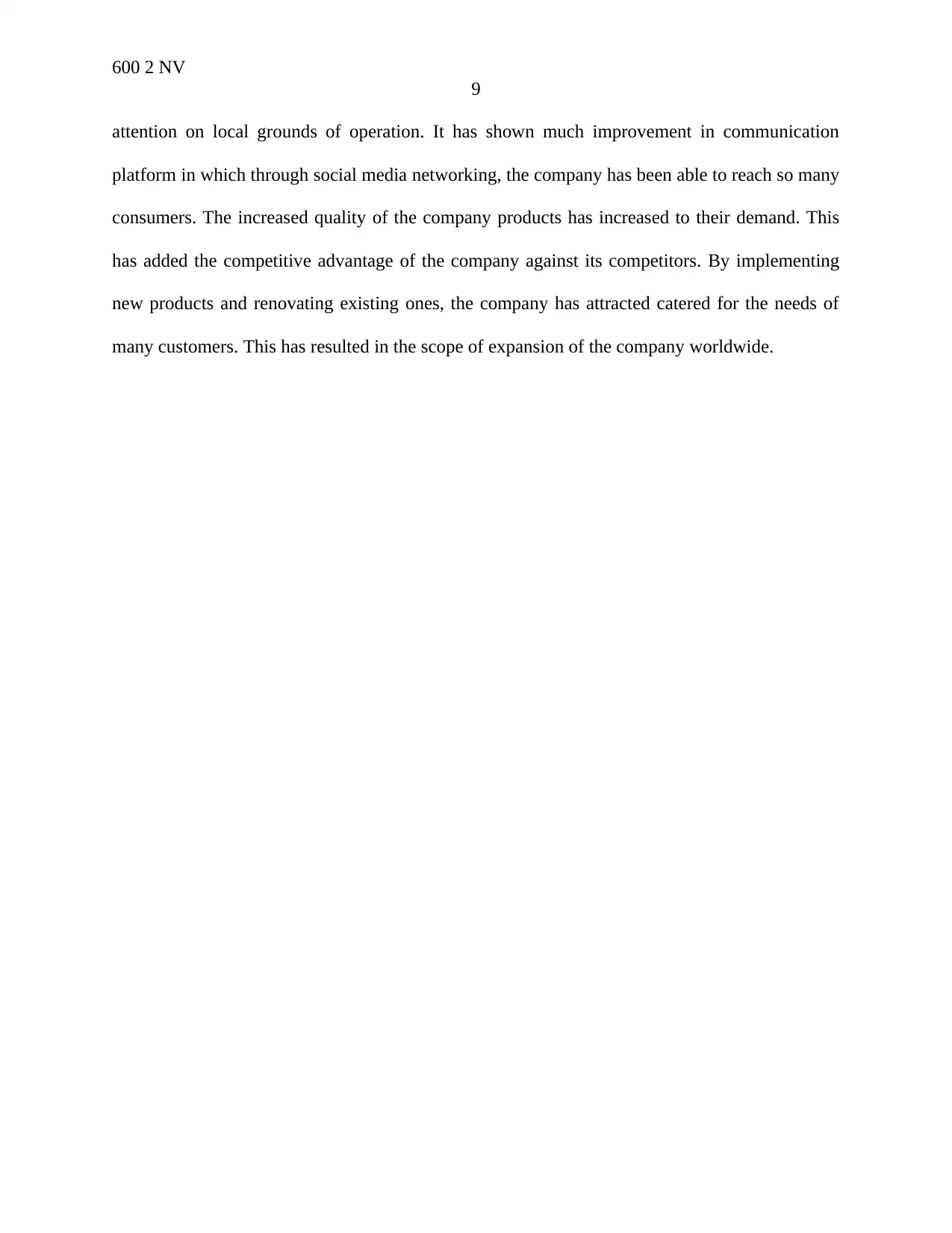
600 2 NV
9
attention on local grounds of operation. It has shown much improvement in communication
platform in which through social media networking, the company has been able to reach so many
consumers. The increased quality of the company products has increased to their demand. This
has added the competitive advantage of the company against its competitors. By implementing
new products and renovating existing ones, the company has attracted catered for the needs of
many customers. This has resulted in the scope of expansion of the company worldwide.
9
attention on local grounds of operation. It has shown much improvement in communication
platform in which through social media networking, the company has been able to reach so many
consumers. The increased quality of the company products has increased to their demand. This
has added the competitive advantage of the company against its competitors. By implementing
new products and renovating existing ones, the company has attracted catered for the needs of
many customers. This has resulted in the scope of expansion of the company worldwide.
⊘ This is a preview!⊘
Do you want full access?
Subscribe today to unlock all pages.

Trusted by 1+ million students worldwide
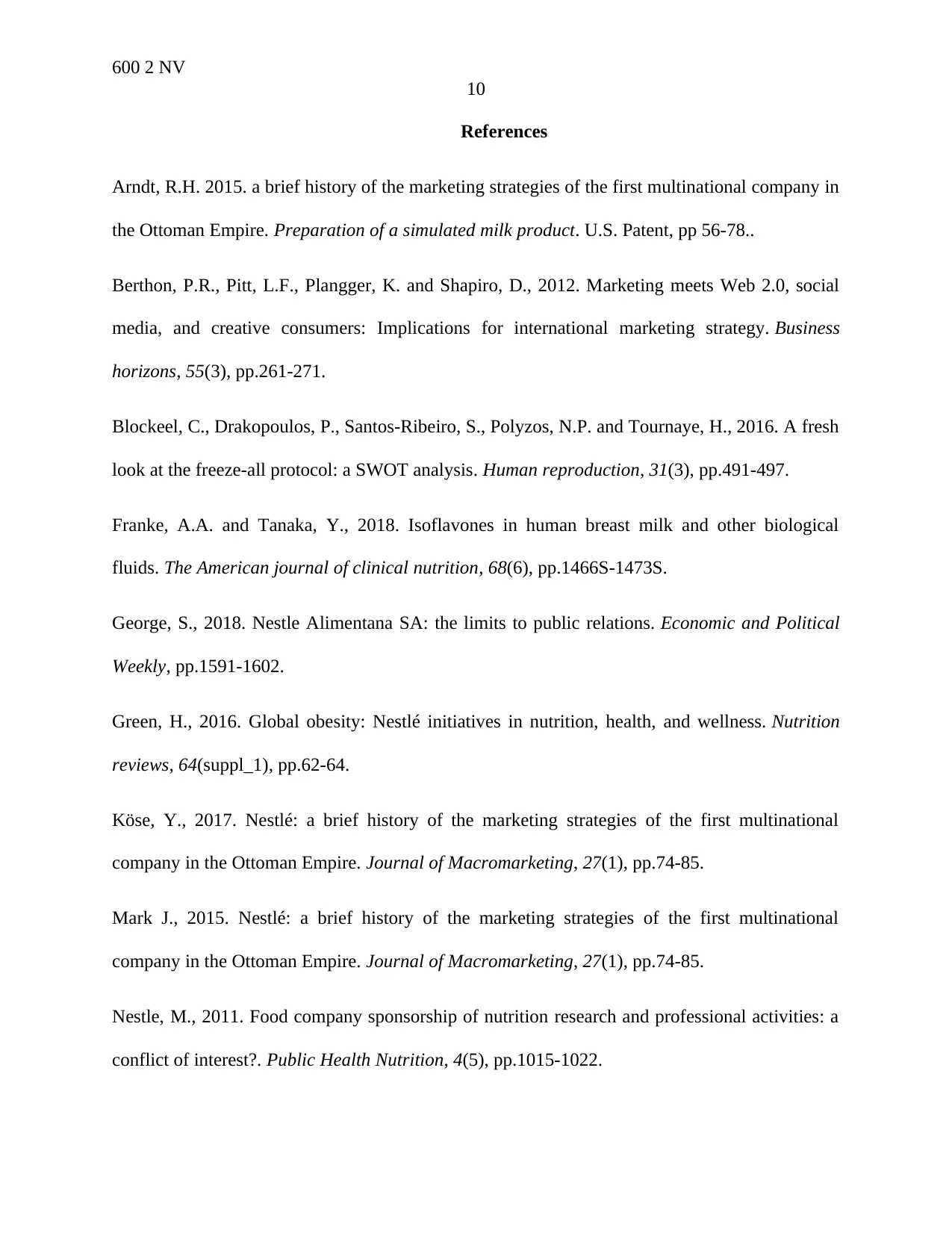
600 2 NV
10
References
Arndt, R.H. 2015. a brief history of the marketing strategies of the first multinational company in
the Ottoman Empire. Preparation of a simulated milk product. U.S. Patent, pp 56-78..
Berthon, P.R., Pitt, L.F., Plangger, K. and Shapiro, D., 2012. Marketing meets Web 2.0, social
media, and creative consumers: Implications for international marketing strategy. Business
horizons, 55(3), pp.261-271.
Blockeel, C., Drakopoulos, P., Santos-Ribeiro, S., Polyzos, N.P. and Tournaye, H., 2016. A fresh
look at the freeze-all protocol: a SWOT analysis. Human reproduction, 31(3), pp.491-497.
Franke, A.A. and Tanaka, Y., 2018. Isoflavones in human breast milk and other biological
fluids. The American journal of clinical nutrition, 68(6), pp.1466S-1473S.
George, S., 2018. Nestle Alimentana SA: the limits to public relations. Economic and Political
Weekly, pp.1591-1602.
Green, H., 2016. Global obesity: Nestlé initiatives in nutrition, health, and wellness. Nutrition
reviews, 64(suppl_1), pp.62-64.
Köse, Y., 2017. Nestlé: a brief history of the marketing strategies of the first multinational
company in the Ottoman Empire. Journal of Macromarketing, 27(1), pp.74-85.
Mark J., 2015. Nestlé: a brief history of the marketing strategies of the first multinational
company in the Ottoman Empire. Journal of Macromarketing, 27(1), pp.74-85.
Nestle, M., 2011. Food company sponsorship of nutrition research and professional activities: a
conflict of interest?. Public Health Nutrition, 4(5), pp.1015-1022.
10
References
Arndt, R.H. 2015. a brief history of the marketing strategies of the first multinational company in
the Ottoman Empire. Preparation of a simulated milk product. U.S. Patent, pp 56-78..
Berthon, P.R., Pitt, L.F., Plangger, K. and Shapiro, D., 2012. Marketing meets Web 2.0, social
media, and creative consumers: Implications for international marketing strategy. Business
horizons, 55(3), pp.261-271.
Blockeel, C., Drakopoulos, P., Santos-Ribeiro, S., Polyzos, N.P. and Tournaye, H., 2016. A fresh
look at the freeze-all protocol: a SWOT analysis. Human reproduction, 31(3), pp.491-497.
Franke, A.A. and Tanaka, Y., 2018. Isoflavones in human breast milk and other biological
fluids. The American journal of clinical nutrition, 68(6), pp.1466S-1473S.
George, S., 2018. Nestle Alimentana SA: the limits to public relations. Economic and Political
Weekly, pp.1591-1602.
Green, H., 2016. Global obesity: Nestlé initiatives in nutrition, health, and wellness. Nutrition
reviews, 64(suppl_1), pp.62-64.
Köse, Y., 2017. Nestlé: a brief history of the marketing strategies of the first multinational
company in the Ottoman Empire. Journal of Macromarketing, 27(1), pp.74-85.
Mark J., 2015. Nestlé: a brief history of the marketing strategies of the first multinational
company in the Ottoman Empire. Journal of Macromarketing, 27(1), pp.74-85.
Nestle, M., 2011. Food company sponsorship of nutrition research and professional activities: a
conflict of interest?. Public Health Nutrition, 4(5), pp.1015-1022.
Paraphrase This Document
Need a fresh take? Get an instant paraphrase of this document with our AI Paraphraser
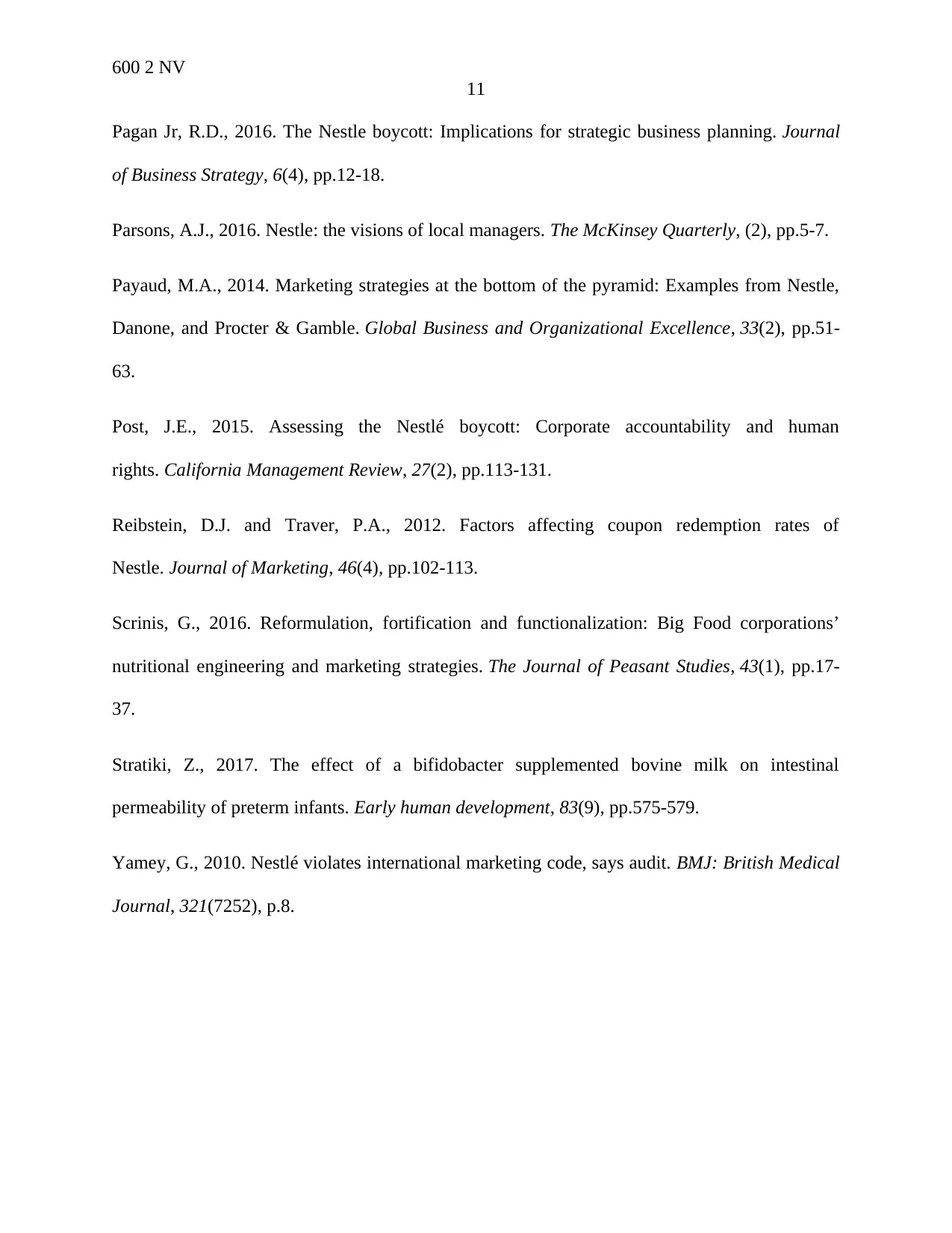
600 2 NV
11
Pagan Jr, R.D., 2016. The Nestle boycott: Implications for strategic business planning. Journal
of Business Strategy, 6(4), pp.12-18.
Parsons, A.J., 2016. Nestle: the visions of local managers. The McKinsey Quarterly, (2), pp.5-7.
Payaud, M.A., 2014. Marketing strategies at the bottom of the pyramid: Examples from Nestle,
Danone, and Procter & Gamble. Global Business and Organizational Excellence, 33(2), pp.51-
63.
Post, J.E., 2015. Assessing the Nestlé boycott: Corporate accountability and human
rights. California Management Review, 27(2), pp.113-131.
Reibstein, D.J. and Traver, P.A., 2012. Factors affecting coupon redemption rates of
Nestle. Journal of Marketing, 46(4), pp.102-113.
Scrinis, G., 2016. Reformulation, fortification and functionalization: Big Food corporations’
nutritional engineering and marketing strategies. The Journal of Peasant Studies, 43(1), pp.17-
37.
Stratiki, Z., 2017. The effect of a bifidobacter supplemented bovine milk on intestinal
permeability of preterm infants. Early human development, 83(9), pp.575-579.
Yamey, G., 2010. Nestlé violates international marketing code, says audit. BMJ: British Medical
Journal, 321(7252), p.8.
11
Pagan Jr, R.D., 2016. The Nestle boycott: Implications for strategic business planning. Journal
of Business Strategy, 6(4), pp.12-18.
Parsons, A.J., 2016. Nestle: the visions of local managers. The McKinsey Quarterly, (2), pp.5-7.
Payaud, M.A., 2014. Marketing strategies at the bottom of the pyramid: Examples from Nestle,
Danone, and Procter & Gamble. Global Business and Organizational Excellence, 33(2), pp.51-
63.
Post, J.E., 2015. Assessing the Nestlé boycott: Corporate accountability and human
rights. California Management Review, 27(2), pp.113-131.
Reibstein, D.J. and Traver, P.A., 2012. Factors affecting coupon redemption rates of
Nestle. Journal of Marketing, 46(4), pp.102-113.
Scrinis, G., 2016. Reformulation, fortification and functionalization: Big Food corporations’
nutritional engineering and marketing strategies. The Journal of Peasant Studies, 43(1), pp.17-
37.
Stratiki, Z., 2017. The effect of a bifidobacter supplemented bovine milk on intestinal
permeability of preterm infants. Early human development, 83(9), pp.575-579.
Yamey, G., 2010. Nestlé violates international marketing code, says audit. BMJ: British Medical
Journal, 321(7252), p.8.
1 out of 11
Related Documents
Your All-in-One AI-Powered Toolkit for Academic Success.
+13062052269
info@desklib.com
Available 24*7 on WhatsApp / Email
![[object Object]](/_next/static/media/star-bottom.7253800d.svg)
Unlock your academic potential
Copyright © 2020–2025 A2Z Services. All Rights Reserved. Developed and managed by ZUCOL.





